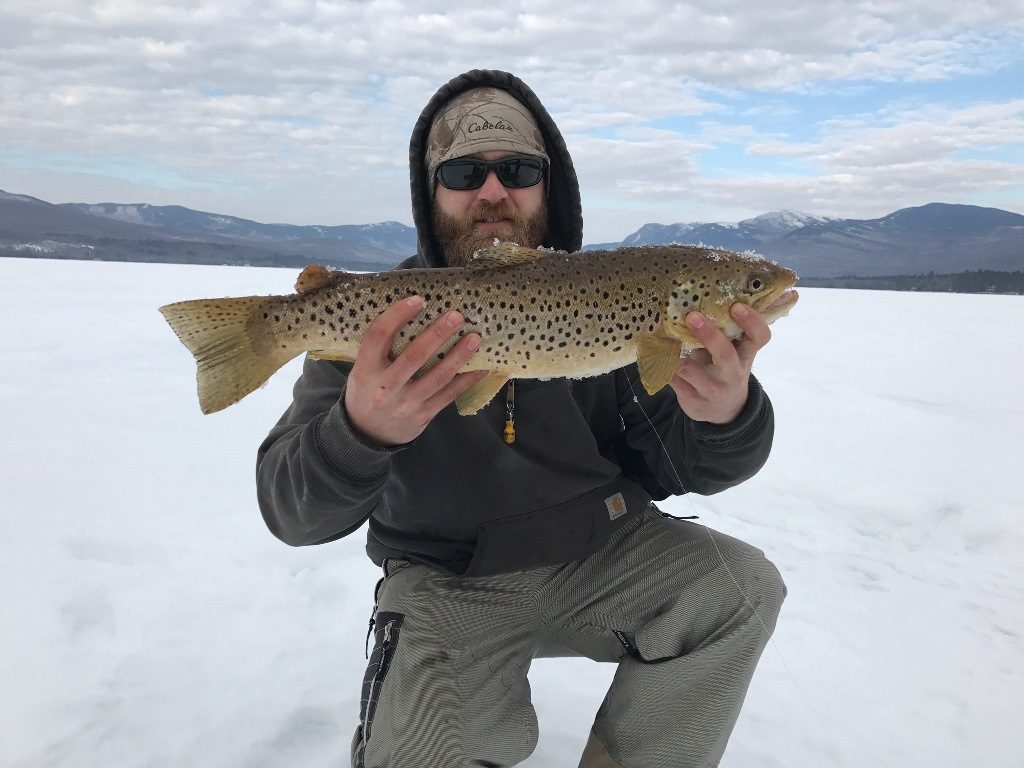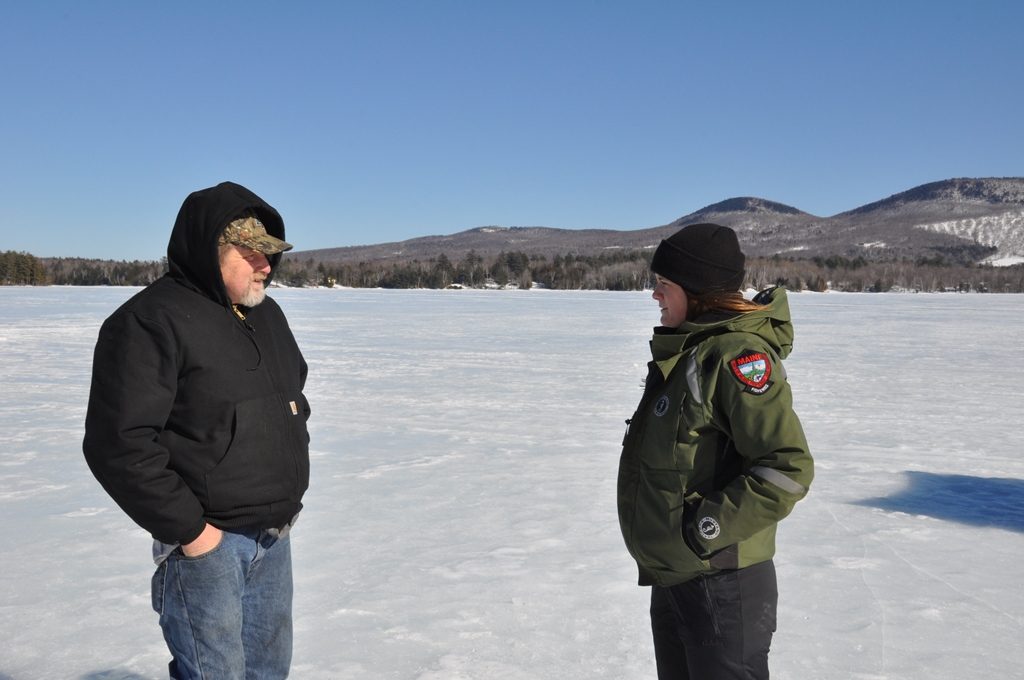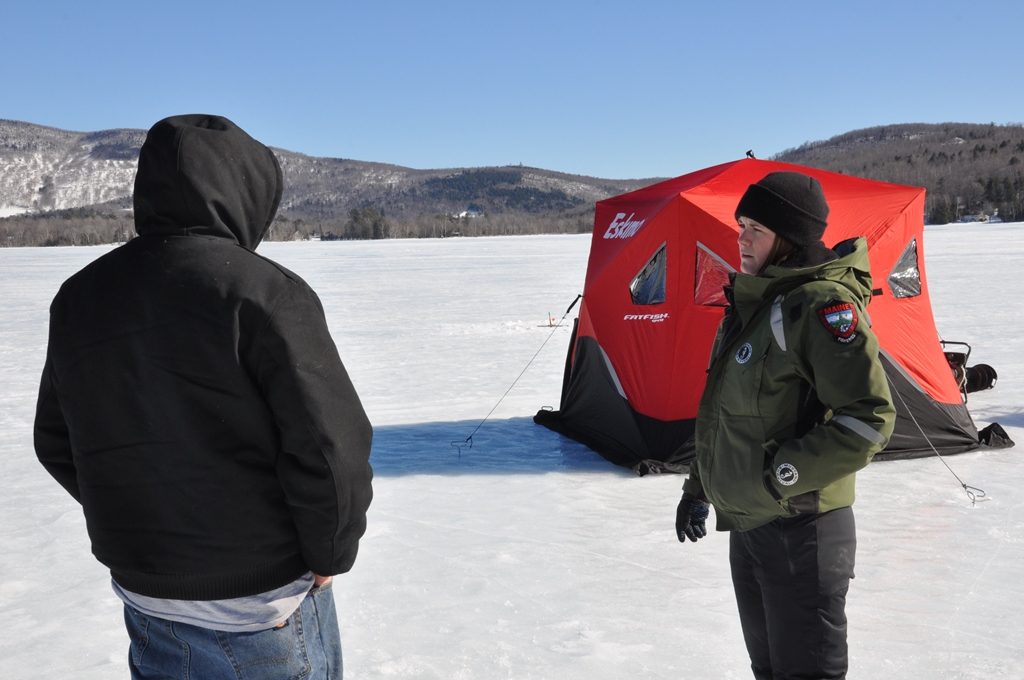April 11, 2017 at 3:38 pm
[caption id="attachment_2252" align="alignright" width="534"] Brad Carlton caught this nice brown trout on Webb Lake, which was one of the lakes Region D fisheries biologists were surveying this year.[/caption]
Creel Surveys are an essential tool for IFW fisheries Biologists. These short, interactive surveys with anglers provide our biologists with the essential information they need to maintain or create a healthy fishery.
So just what is a creel survey? It may seem as simple as asking anglers about their day fishing.
“We ask what time they started fishing, how many people are fishing, what they caught, what they released, and then we get lengths, weights, and scales from the fish they kept,” says IFW’s Liz Thorndike, a fisheries biologist in the Rangeley Lakes region.
The questions may seem simple enough, but the answers can provide important clues to the health of a fishery.
Each week from January through March, fisheries biologists in Rangeley region will visit each pond two days during the week and one day during the weekend. This gives biologists a clearer picture of the fishing pressure throughout the week. Come spring, biologists will also conduct open water surveys as well.
This ice fishing season, biologists in the Rangeley Lakes region will have intensely surveyed five different lakes. Crews rotate lakes every two to five years, and during that course of time, they will rotate through nearly 30 waters.
[caption id="attachment_2253" align="alignleft" width="426"]
Brad Carlton caught this nice brown trout on Webb Lake, which was one of the lakes Region D fisheries biologists were surveying this year.[/caption]
Creel Surveys are an essential tool for IFW fisheries Biologists. These short, interactive surveys with anglers provide our biologists with the essential information they need to maintain or create a healthy fishery.
So just what is a creel survey? It may seem as simple as asking anglers about their day fishing.
“We ask what time they started fishing, how many people are fishing, what they caught, what they released, and then we get lengths, weights, and scales from the fish they kept,” says IFW’s Liz Thorndike, a fisheries biologist in the Rangeley Lakes region.
The questions may seem simple enough, but the answers can provide important clues to the health of a fishery.
Each week from January through March, fisheries biologists in Rangeley region will visit each pond two days during the week and one day during the weekend. This gives biologists a clearer picture of the fishing pressure throughout the week. Come spring, biologists will also conduct open water surveys as well.
This ice fishing season, biologists in the Rangeley Lakes region will have intensely surveyed five different lakes. Crews rotate lakes every two to five years, and during that course of time, they will rotate through nearly 30 waters.
[caption id="attachment_2253" align="alignleft" width="426"] Biologists will ask questions like how long have you been fishing, how many people are fishing, what have you been catching, and what has been released. Biologists will also take lenghts and weights of fish kept, as well as scales to age later.[/caption]
But the real work comes after the data is gathered. Scales are aged much like the cross section of a tree – by counting the annuli – the lines that differentiate a year’s growth on a scale. The length and weight of a fish are used to calculate the condition, (K) factor, revealing the relative health of the fish.
Catch rates are determined by comparing the number of fish caught in relation to the number of hours and how many people are fishing. Biologists also note the percent of stocked fish that are caught versus the percent of wild fish, and cross reference that.
The survey also provides a glimpse into the fishing pressure on a water. The specific angler counts for each day of the survey can be projected over a season. Combining that with catch rates and K factors provides biologists with an accurate projection of how many fish are harvested from that water.
“All our creel waters are stocked, so we can take the information that we gather and analyze the stocking rates so we can make sure we have the right balance,” says Thorndike.
Finding that right balance, through surveys, regulations, and stocking allow biologists to provide anglers with a wide variety of fishing opportunities and maintain a healthy fishery.
[caption id="attachment_2254" align="alignleft" width="660"]
Biologists will ask questions like how long have you been fishing, how many people are fishing, what have you been catching, and what has been released. Biologists will also take lenghts and weights of fish kept, as well as scales to age later.[/caption]
But the real work comes after the data is gathered. Scales are aged much like the cross section of a tree – by counting the annuli – the lines that differentiate a year’s growth on a scale. The length and weight of a fish are used to calculate the condition, (K) factor, revealing the relative health of the fish.
Catch rates are determined by comparing the number of fish caught in relation to the number of hours and how many people are fishing. Biologists also note the percent of stocked fish that are caught versus the percent of wild fish, and cross reference that.
The survey also provides a glimpse into the fishing pressure on a water. The specific angler counts for each day of the survey can be projected over a season. Combining that with catch rates and K factors provides biologists with an accurate projection of how many fish are harvested from that water.
“All our creel waters are stocked, so we can take the information that we gather and analyze the stocking rates so we can make sure we have the right balance,” says Thorndike.
Finding that right balance, through surveys, regulations, and stocking allow biologists to provide anglers with a wide variety of fishing opportunities and maintain a healthy fishery.
[caption id="attachment_2254" align="alignleft" width="660"] Fisheries staff will interview hundreds of anglers over the course of an ice fishing season. The information provided by anglers gives biologists a clearer picture of the health of a fishery.[/caption]
Fisheries staff will interview hundreds of anglers over the course of an ice fishing season. The information provided by anglers gives biologists a clearer picture of the health of a fishery.[/caption]
 Brad Carlton caught this nice brown trout on Webb Lake, which was one of the lakes Region D fisheries biologists were surveying this year.[/caption]
Creel Surveys are an essential tool for IFW fisheries Biologists. These short, interactive surveys with anglers provide our biologists with the essential information they need to maintain or create a healthy fishery.
So just what is a creel survey? It may seem as simple as asking anglers about their day fishing.
“We ask what time they started fishing, how many people are fishing, what they caught, what they released, and then we get lengths, weights, and scales from the fish they kept,” says IFW’s Liz Thorndike, a fisheries biologist in the Rangeley Lakes region.
The questions may seem simple enough, but the answers can provide important clues to the health of a fishery.
Each week from January through March, fisheries biologists in Rangeley region will visit each pond two days during the week and one day during the weekend. This gives biologists a clearer picture of the fishing pressure throughout the week. Come spring, biologists will also conduct open water surveys as well.
This ice fishing season, biologists in the Rangeley Lakes region will have intensely surveyed five different lakes. Crews rotate lakes every two to five years, and during that course of time, they will rotate through nearly 30 waters.
[caption id="attachment_2253" align="alignleft" width="426"]
Brad Carlton caught this nice brown trout on Webb Lake, which was one of the lakes Region D fisheries biologists were surveying this year.[/caption]
Creel Surveys are an essential tool for IFW fisheries Biologists. These short, interactive surveys with anglers provide our biologists with the essential information they need to maintain or create a healthy fishery.
So just what is a creel survey? It may seem as simple as asking anglers about their day fishing.
“We ask what time they started fishing, how many people are fishing, what they caught, what they released, and then we get lengths, weights, and scales from the fish they kept,” says IFW’s Liz Thorndike, a fisheries biologist in the Rangeley Lakes region.
The questions may seem simple enough, but the answers can provide important clues to the health of a fishery.
Each week from January through March, fisheries biologists in Rangeley region will visit each pond two days during the week and one day during the weekend. This gives biologists a clearer picture of the fishing pressure throughout the week. Come spring, biologists will also conduct open water surveys as well.
This ice fishing season, biologists in the Rangeley Lakes region will have intensely surveyed five different lakes. Crews rotate lakes every two to five years, and during that course of time, they will rotate through nearly 30 waters.
[caption id="attachment_2253" align="alignleft" width="426"] Biologists will ask questions like how long have you been fishing, how many people are fishing, what have you been catching, and what has been released. Biologists will also take lenghts and weights of fish kept, as well as scales to age later.[/caption]
But the real work comes after the data is gathered. Scales are aged much like the cross section of a tree – by counting the annuli – the lines that differentiate a year’s growth on a scale. The length and weight of a fish are used to calculate the condition, (K) factor, revealing the relative health of the fish.
Catch rates are determined by comparing the number of fish caught in relation to the number of hours and how many people are fishing. Biologists also note the percent of stocked fish that are caught versus the percent of wild fish, and cross reference that.
The survey also provides a glimpse into the fishing pressure on a water. The specific angler counts for each day of the survey can be projected over a season. Combining that with catch rates and K factors provides biologists with an accurate projection of how many fish are harvested from that water.
“All our creel waters are stocked, so we can take the information that we gather and analyze the stocking rates so we can make sure we have the right balance,” says Thorndike.
Finding that right balance, through surveys, regulations, and stocking allow biologists to provide anglers with a wide variety of fishing opportunities and maintain a healthy fishery.
[caption id="attachment_2254" align="alignleft" width="660"]
Biologists will ask questions like how long have you been fishing, how many people are fishing, what have you been catching, and what has been released. Biologists will also take lenghts and weights of fish kept, as well as scales to age later.[/caption]
But the real work comes after the data is gathered. Scales are aged much like the cross section of a tree – by counting the annuli – the lines that differentiate a year’s growth on a scale. The length and weight of a fish are used to calculate the condition, (K) factor, revealing the relative health of the fish.
Catch rates are determined by comparing the number of fish caught in relation to the number of hours and how many people are fishing. Biologists also note the percent of stocked fish that are caught versus the percent of wild fish, and cross reference that.
The survey also provides a glimpse into the fishing pressure on a water. The specific angler counts for each day of the survey can be projected over a season. Combining that with catch rates and K factors provides biologists with an accurate projection of how many fish are harvested from that water.
“All our creel waters are stocked, so we can take the information that we gather and analyze the stocking rates so we can make sure we have the right balance,” says Thorndike.
Finding that right balance, through surveys, regulations, and stocking allow biologists to provide anglers with a wide variety of fishing opportunities and maintain a healthy fishery.
[caption id="attachment_2254" align="alignleft" width="660"] Fisheries staff will interview hundreds of anglers over the course of an ice fishing season. The information provided by anglers gives biologists a clearer picture of the health of a fishery.[/caption]
Fisheries staff will interview hundreds of anglers over the course of an ice fishing season. The information provided by anglers gives biologists a clearer picture of the health of a fishery.[/caption]Categories